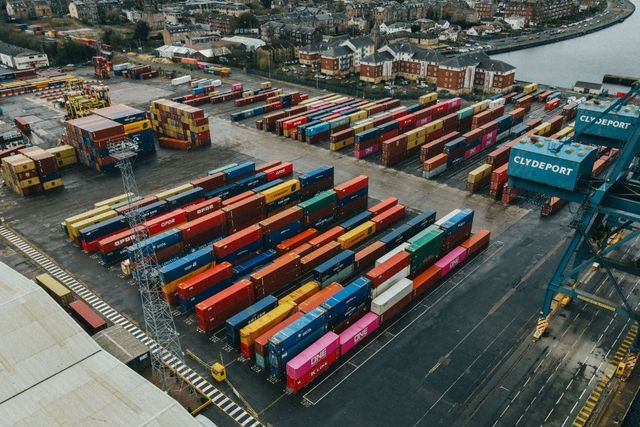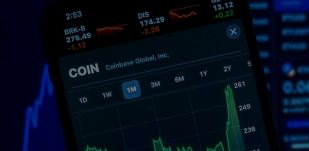What’s the Trade Forecast for the Shipping Industry?
The shipping industry appears to have weathered the Covid-19 storm - but will it find itself in the doldrums by 2023? According to a 2021 United Nations report, trade on the high seas contracted by 3.8% in 2020 amid an initial shock from the pandemic, before rebounding later that year. This resurgence generated tailwinds for the industry in 2021 that drove an 8.3% swell in global trade volumes:

Cargo containers, Scotland
However, the report forecasts that annual growth in maritime trade between 2022 and 2026 will slow to 2.4%, compared to 2.9% over the past two decades - and it’s easy to see why. The short to medium-term forecast for maritime trade will be subject to new and existing risks - from geopolitical tensions in Europe and decades-high inflation to pressures in global supply chains and choppy demand for goods.
So how might some of these shipping trends impact an industry that is widely regarded as the lifeblood of the global economy?
Shipping industry trade forecast amid war in Ukraine
Uncertainty surrounding the war in Ukraine is impacting the global economy and world trade. Despite a double-digit bounceback beyond pre-pandemic levels, a combination of conflict-fuelled headwinds could limit trade growth. With 80-90% of world trade travelling by sea, the shipping forecast could - largely - suffer.
Shipping costs
Trade volumes are being impacted by spiralling shipping costs amid the war in Ukraine. Most notably bunker fuel prices, which make up a significant portion of total operational cost in shipping. This fuel bill can easily exceed half of the total operating costs for larger vessels at the best of times. Global bunker fuel prices in shipping were close to all-time highs in the first months of 2022, which placed a huge strain on what is one of the most energy-intensive industries.
Congestion at ports
The knock-on effect of the conflict is being felt at ports like Rotterdam, Antwerp, and Hamburg, where the suspension of Russian destinations by large carriers - including MSC and Maersk - and extra customs checks, are causing congestion that’s strangling supply chains. Moreover, Russian vessels - which make up around 3% of the global fleet - have been banned from the ports of several countries including the EU and the UK.
Labour shortages
Russians make up the second-largest number of seafarers (10.5%) after the Philippines. Combined with seafarers from Ukraine (4%), this totals 15% of the global shipping workforce. Their absence will exacerbate ongoing pandemic-induced labour shortages, creating further operational challenges that could dent trade volumes.
Russian oil diversion
The EU is poised to deprive Russia - one of the world's top oil producers - of oil revenues by banning Russian crude imports by 5th December this year and Russian oil products by 5th February 2023. With Russia forced to seek alternative markets, the sanctions will trigger a mammoth shift in global trade flows as nearly 3 million barrels per day of Russian crude oil and products are shipped elsewhere.
As trade flows are redirected and routes reshaped, the average voyage time for Russian oil exports will increase. The average time to Europe is around seven days, but if the export is routed to Asia once the sanctions take effect, it will take three times longer, at around 21 days. This equates to an approximately 3% increase in shipping activity measured in ton-miles and will increase the number of ships required for these trades.
Switch to coal
A substitution in energy sources in Europe, which wants to reduce its pipeline natural gas dependency on Russia, could boost shipments of coal in coal handling ports like Rotterdam. This temporary switch back to coal in the energy sector is already underway in the face of soaring gas prices.
Supply chains
As the global shipping sector rebounded from the pandemic, a lack of capacity to meet the wave of demand disbalanced global supply chains. The situation started to improve in the first few months of 2022, before the Russian invasion of Ukraine and fresh lockdowns in China caused further disruption to trade and global shipping. Consequently, supply chain problems are expected to persist and capacity pressures continue amid acute shortages of vessel space, container boxes, chassis, warehouse space, and labour.
Subsequent shipping bottlenecks have raised a serious question facing the post-pandemic global economy: will the worldwide traffic jam remain gridlocked or begin to flow again soon? If it persists, freight costs will spiral, space for cargo on ships will be restricted, and retailers and manufacturers will have to put up with severe delays. That could in turn heat up inflation - which recently touched a double-digit, 40-year high in the UK - prompt further supply chain upheavals and consolidate shipping networks, fundamentally reshaping world trade.
Weaker demand for goods
The strength of consumer goods demand plays a crucial role in dictating shipping trade flows - particularly Chinese goods. The cost of shipping goods from China recently slumped to the lowest level in over two years as the world economy stutters, raising alarm bells for container carriers.
In September, a 40-foot shipping box from China to the US west coast fetched less than $4,000 for the first time since September 2020 and half the level paid in June - with further declines forecast by independent maritime research consultancy Drewry. The drop in value can be attributed to a barrage of headwinds buffeting developed and developing economies alike - from sky-high inflation and a surging dollar to central bank interest rate hikes and trade disruptions caused by Russia. This is not causing US container imports to fall off a cliff, but they’re easing to more typical levels seen before the pandemic.
Global demand for Chinese goods is dwindling during what is recognised as the peak season for seaborne trade, as consumers tighten their purse strings in the face of inflation and shift away from goods toward services. Shanghai - the world’s largest port - processed 8.4% less cargo in August 2022 than 12 months earlier, with the number of containers down 3.4%.
China’s economic slowdown is causing manufacturers in Europe and the rest of Asia to experience weaker growth or declines in orders from Chinese companies. This softening demand is forcing companies in these regions to trim their output and causing freight rates to drop. The shipping industry wants exporters to raise their volumes, but many are wary of doing so amid the weaker economic outlook.
These conditions are providing some relief for the world’s shipping lines, which have hugely congested schedules created by pandemic backlogs. However, they threaten to slow a staggering surge in profitability generated by stronger-than-normal consumer demand for household items during the pandemic.
Industry analysts say shipping could record its third-best year in 2023 before stalling given all the new ships - ordered when demand for goods was much higher - that will hit the water next year.
Currency risk exposure
The sudden and unexpected storm created by the pandemic not only clouded the shipping industry forecast; it underscored the importance of managing a vital element of international business: currency risk exposure. This has been amplified recently after the pound plummeted to a record low against the dollar as markets reacted to the UK's biggest tax cuts in 50 years.
This unprecedented fall in the value of the pound intensified cost pressure in the shipping industry - and provided opportunities to cash in on the strong dollar. Every provider typically makes several international payments to pay for a single journey - from crew salaries and onboard supplies to fuel and docking fees. All of which must be settled at different points before and after the journey. This might require you to make multiple payments in different currencies to pay for your vessels, exposing you to currency risk.
Clear Currency
With so many external variables to consider when operating in the shipping industry - particularly against the backdrop of the worldwide shipping trade forecast - there is one thing your business can mitigate: exposure to currency risk.
Clear Currency specialises in helping businesses that are exposed to currency market risk save money when making international payments - both large and small. Transferring money into another currency and transferring it overseas can be daunting and confusing. Aware of this, we use our knowledge and experience to cut through the jargon and provide you with a friendly and personal service.
Open your free Clear Currency account today for quick, secure and cost-effective international currency transfers.
Related Articles
How to Mitigate Foreign Exchange Risk
Currency risk can have a significant effect on the efficiency and profitability of any international business. Each exchange rate movement affects how much you receive from sales and what you pay to suppliers.
Read more
Moving to Dubai from the UK: Checklist
You’re ready for a new life overseas and have decided you’re moving to Dubai. Now it’s time to consider the various costs involved, from your visa and accommodation, to health insurance, shipping your belongings and bringing your beloved pets along too.
Read more
Currency Outlook Quarter 1 2023
Clear Currency looks back at the performance of the US dollar, euro and sterling in Q4 2022, and assesses what might be in store for Q1 2023.
Read more


